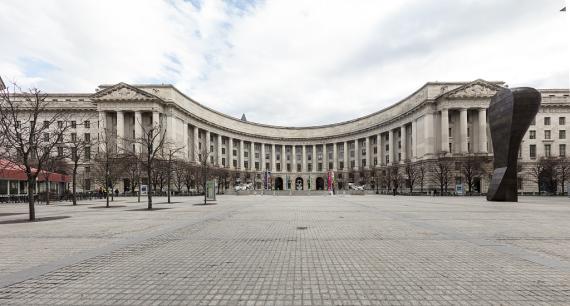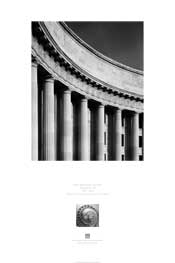Location: 1201 Constitution Ave. NW, Washington, DC 20460
History
The William J. Clinton Federal Building is part of the Federal Triangle government complex in Washington, DC. It was constructed in the 1930s as the headquarters for the U.S. Post Office Department, which was then one of the largest civilian employers in the country. Referred to as the New Post Office, it replaced a succession of post offices, including the 1890s Old Post Office building located across 12th Street.
By the early twentieth century, the area north of the National Mall between the Capitol and the White House was one of the city’s most blighted neighborhoods. Referred to as Murder Bay, it was a center of crime and prostitution instead of the grand locale that Pierre Charles L’Enfant envisioned as part of his 1791 plan of Washington.
In an attempt to improve the city, planners decided to fulfill L’Enfant’s intention while incorporating the ideals of the City Beautiful movement. The result of their efforts was the McMillan Plan of 1901—the first federally funded urban redevelopment plan. Distinguished office buildings executed in classical styles of architecture would replace the blight and assert the power and permanence of the government.
Architects William A. Delano and Chester H. Aldrich created a monumental building with a semicircular facade to front the grand plaza planners envisioned for the center of the Federal Triangle. Their design was intended to rival the magnificence of public buildings in other world capitals. They drew inspiration from London County Hall and Place Vendame in Paris. Using the same trowel that President George Washington used to lay the Capitol’s cornerstone in 1793, President Herbert Hoover laid the cornerstone in 1932.
In 1971, the U.S. Post Office Department became the U.S. Postal Service and shortly after vacated its headquarters. Renamed the Ariel Rios Federal Building in 1985 to honor a fallen Alcohol, Tobacco and Firearms agent, the building still has a post office, but the Environmental Protection Agency is the main occupant. In 2013, it was again renamed to honor President William Jefferson Clinton. It is part of the Pennsylvania Avenue National Historic Site designated by Congress in 1966.
Architecture
The William J. Clinton Federal Building is eight stories in height and has an unusual footprint that is essentially two semicircles back to back with side wings, resulting in a dramatic sweeping facade. The building is designed in the Classical Revival architectural style. Characteristics of the style found on the building include monumental columns, dentils (square blocks), and balustrades. The exterior is clad in limestone, with granite used to cover the basement level. The rusticated two-story base contains limestone blocks with deeply recessed joints.
The exterior displays columns, porticos, and arcades (arched openings) that are arranged slightly differently on each elevation. The 12th Street elevation is dominated by a colossal portico (entrance porch with columns) and pediment (triangular gable end) that projects from the curved facade and marks the location of the entrance doors. Scrolled Ionic marble columns support a triangular pediment, and similarly designed pilasters (attached columns) are located on the exterior wall. The Pennsylvania Avenue elevation also has a projecting portico that marks the entrance to the Benjamin Franklin Post Office. The pediment is supported by fluted Doric columns that have less ornate capitals than the Ionic columns on the 12th Street elevation. Paneled bronze doors are decorated with molding and floral motifs. The 13th Street elevation is not as varied in detail. It incorporates another dominant portico, and classical motifs on this facade include marble urns, dentils, and acanthus leaves.
The exterior is embellished by sculpture and bas relief panels depicting the significance of the postal service. They were designed by German-born artist Adolph Alexander Weinman, whose work can also be seen on the Supreme Court and National Archives buildings.
The interior was richly appointed with superb finishes. Parquet and marble floors, bronze and chrome lighting fixtures, and mahogany, black walnut, oak, and butternut woodwork are found throughout the building. Much of the stone, wood, metal, and plaster was crafted and installed by hand. The public spaces on the first floor—the entrance and elevator lobbies, postal station, and library—are elaborate. The lavish interior spaces within the original U.S. Postmaster General’s suite, which contains four offices and a conference room on the third floor, are among the finest in Federal buildings. The major spaces contain butternut paneling and marble fireplaces. Distinctive chandeliers with glass and chrome light the rooms.
Starburst chandeliers with exposed light bulbs descend seven stories through the open center of two magnificent marble circular staircases. alluding to the post office mission, a design of twisted serpents surmounted by wings, a traditional symbol of Mercury, Roman messenger of the gods, decorates The bronze balustrades.
Art is an integral component of the interior. Commissioned by the Section of Fine Arts during the 1930s, 24 murals depict the country’s postal heritage and a ceiling mural depicts the 4 seasons and Zodiac signs. Figurative sculptures are found throughout the building.
While traditional materials were used to construct portions of the building, modern materials such as cork, nickel silver, and structural glass were also used. The building had the first central air-conditioning system in a federal building, chilled drinking water, and one of the first central vacuum systems in the country. The cafeteria contained state-of- the-art electric potato peelers, spinach washers, and pea shellers.
In 1993, the U.S. General Services Administration began a building restoration and upgrade. Historic features were kept while state-of-the-art environmental systems were added.
Significant Events
- 1901: McMillan Plan
- 1934: Construction completed
- 1966: Pennsylvania Avenue Historic Site designated
- 1971: U.S. Post Office Department becomes U.S. Postal Service
- 1985: Building renamed Ariel Rios Federal Building
- 1993: Renovation to upgrade the building for the Environmental Protection Agency commenced
- 2013: Building renamed in honor of President William Jefferson Clinton
Building Facts
- Architects: William A. Delano and Chester H. Aldrich
- Architectural Style: Neoclassical Revival
- Construction Dates: 1931-1934
- GSA Building Number: DC0028ZZ
- National Register of Historic Places Landmark Status: Located within the boundaries of the Pennsylvania Avenue Historic Site
- Primary Material: Limestone
- Prominent Features: Sweeping Classical Facade; U.S. Postmaster General’s Suite; Winding Marble Staircases; Murals and Sculpture
Poster Download
Download the poster [PDF - 614 KB]

 U.S. General Services Administration
U.S. General Services Administration

